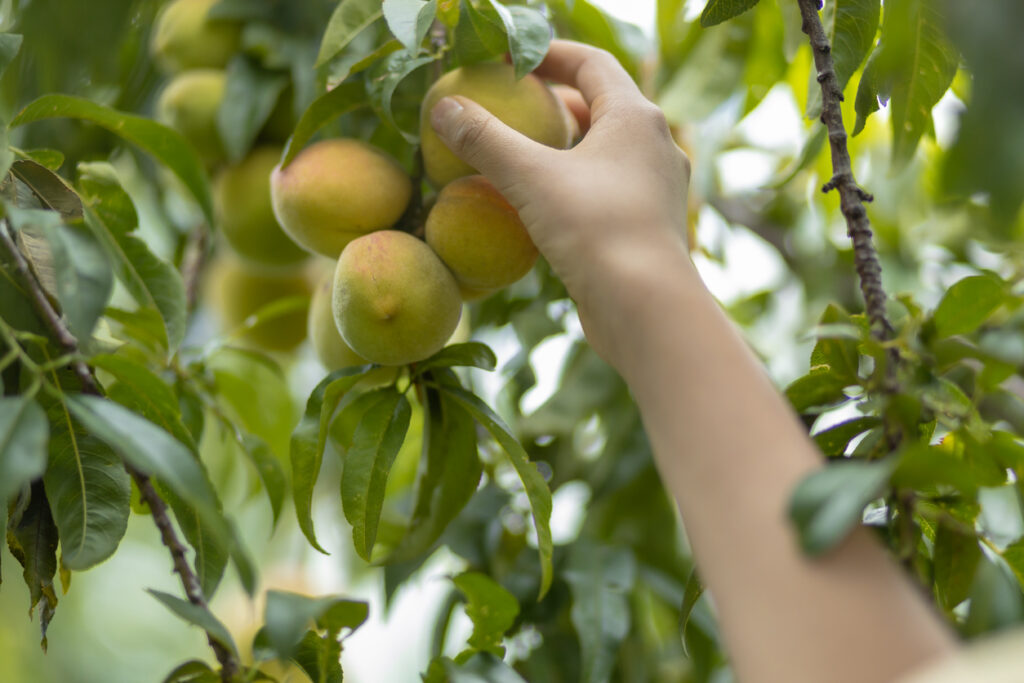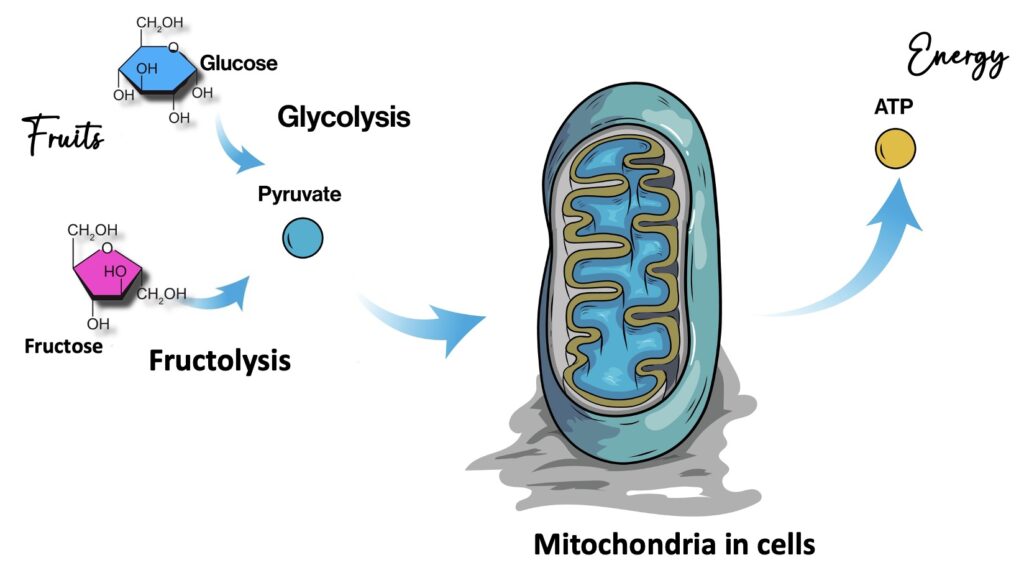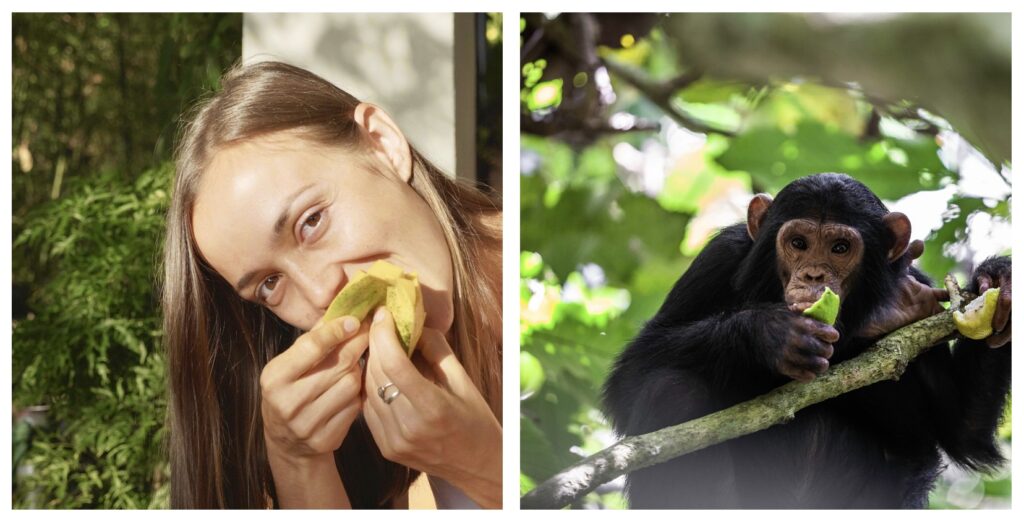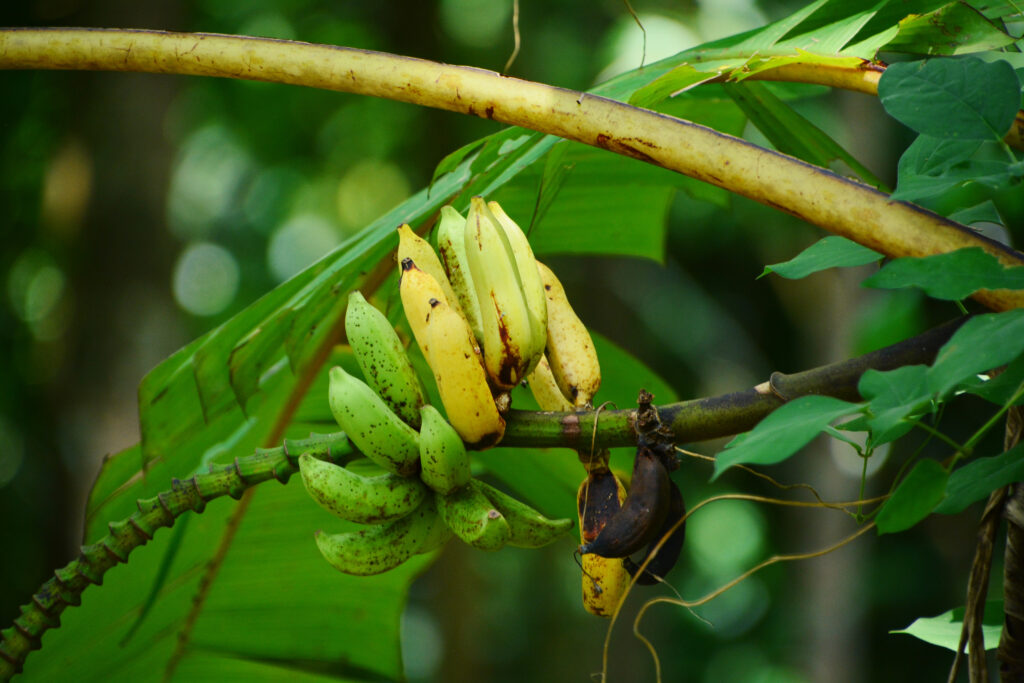Tropical fruits are often perceived as a tasty “bag of sugar and water” which should be seen as a treat… but they are so much more than that! Many wild tropical fruits are our evolutionary food and provide healthy energy, nutrients and health benefits.
Sugar in fruits is increasingly portrayed as unhealthy. In fact, there is a whole myth out there that deems sugar as “a toxin”. This is not true on so many levels, but unfortunately, the narrative promotes the nutritional mistake of avoiding sweet fruits! Learn how much sugar the healthiest fruits – tropical fruits – contain and why this is actually a good thing!
Different fruits and their protein and sugar content
Sugar content of tropical and temperate fruits
Generally, watery and temperate fruits contain less sugar than their tropical counterparts, which is why they are often portrayed as healthier.
However, it is the tropical fruits that are the natural food source of apes and early human ancestors, which evolved in African tropical forested regions as frugivores. This is why tropical fruits are still a perfect nutritional match for the human body today as our evolutionary foods!

Most temperate fruits, on the other hand, have not evolved with mammals – but with birds – as a food source. Temperate fruits have undergone extensive selective breeding that turned them sweeter and bigger – so that they resemble tropical fruits and suit human preferences (read more here).

Sweet tropical fruits can contain up to 35 grams of carbohydrates per 100 grams. More acidic tropical fruits are in the same range as most modern, cultivated temperate fruits, around 10 grams per 100 grams:
| Fruit Type | Sugar (g) |
|---|---|
| Mango | 14 |
| Lucuma | 28 |
| Passion fruit | 11 |
| Durian | 16-35 |
| Bananas | 12 |
| Jackfruit | 31 |
| Cherimoya | 21 |
| Papaya | 10 |
| Mangosteen | 35 |
| Dragon fruits | 10 |
| Lychee | 29 |
| Fruit Type | Sugar (g) |
|---|---|
| Apple | 10 |
| Plums | 10 |
| Cherries | 8 |
| Blueberries | 9 |
| Apricots | 9 |
Sweet fruits instead of complex carbs? Not a bad idea!
Compared to complex carbs, like cooked pasta or rice, sweet fruit contains a similar carb load. Despite this fact, sweet fruits are more often avoided and perceived as “sugary” compared to complex carb foods, which are seen as a healthy part of a balanced diet.
From an evolutionary perspective, sweet tropical fruits are a healthier alternative to complex carbs and grains, which are high in anti-nutrients.
| Complex Carb Food | Sugar (g) |
|---|---|
| Fresh cooked pasta | 25 |
| Bread | 13 |
| Roasted potatoes | 27 |
| Cooked rice | 44 |
| Cooked corn pasta | 39 |
Let’s explore why the high sugar content of tropical fruits fuels you:
Simple sugars as a fuel and energy booster
Simple sugars from fruits, glucose and fructose, are our natural energy sources. In contrast to complex carbs in grains and starches, they can be eaten raw, and unaltered because we have evolved to eat them. Fructose, the simple sugar typical for fruits (which is where it got its name from) enters cells without insulin spikes, via a specific fructose transporter (GLUT5). Those transporters are basically open doors for those particular sugar molecules, letting them pass across the cell membranes passively! This means it’s easily obtainable – and welcomed – energy for cells to fuel the metabolism.
Fructose is used as fuel by many different types of cells in our body, including muscle and brain tissue, for fuel. Fructose does not necessarily have to be processed and converted by the liver first, which is an outdated and long-hold belief (based on studies of isolated high-fructose syrups) that has been proven wrong.

Many types of cells can use both, glucose and fructose to obtain energy in the form of adenosine triphosphate (ATP).
ATP is an energetically charged carrier of phosphate groups, that provides the energy needed for most metabolic processes in the body (the ones that require energy). This includes not only muscle power but also uncountable enzymatic reactions and processes in the body. No energy, no life.
Sugar-rich sweet fruits are beneficial for you
While we know that too much (isolated) sugar is a promotor of obesity and chronic health issues, the natural sweet sugars in fruits are not! This is reflected in the fact that fructose from fruits does not cause obesity or insulin issues. Fruits have been shown to be health-promoting in countless studies, and it is one of the – rare – consensus that fruits are important in a healthy diet. This includes sweet tropical fruits like papaya, mango, banana, and durian.
Because of their positive effects and simultaneous high sugar content, fruits are said to present paradoxes:
- Fruits are high in simple sugars but counteract obesity.
- Fruits contain sugar, but help regulate insulin.
But what about rethinking sugar by looking at it in a more differentiated way? What could be the reasons that sweet fruits promote health despite their sugar content? Here are a few:
- Optimal energy source: Simple sugars are the energy source we have evolved to eat
- Insulin stability: Fructose prevents insulin spikes and blood sugar spikes
- Evolutionary past: Fruits are nutritionally matched to primates (including humans)
- Fiber content: Fruits have a low glycemic index, due to high fiber content and fructose content
- Antioxidant action: Fruits contain high levels of vitamin C and other antioxidants that counteract the oxidative stress from energy production.
- High in nutrients: Tropical fruits contain many essential minerals and vitamins in higher levels than temperate fruits, like magnesium, potassium, chromium, vitamin C, boron, sulfur, and silica, among others. Nutrients promote metabolic integrity, which is a key to nearly everything in health.
- Low in toxicity: Fruits contain very low polyphenolic toxicity compared to other plant foods, due to the lack of defense mechanisms against their symbiotic consumers (seed-dispersers coevolve with fruits, a dynamic called dispersal syndrome)
Wild fruits contain more fructose than cultivated fruits
Not only do sweet fruits – wrongly – get a bad reputation for their sugar content, but they are also completely ignored as humans’ evolutionary foods. Our early ancestors and our closest living relatives, all apes, are highly frugivorous.
Further, it is a misconception that “modern” fruits are too sweet! Wild fruits, tropical fruits, are actually sweeter and contain more fructose than cultivated fruits. Our closest relatives, apes, are adapted to getting their energy from fructose-rich fruits.
“Humans clearly come from an evolutionary past in which hexose (fructose) – rather than sucrose-dominated fruits were consumed, and human digestive physiology should, therefore, be best adapted to a carbohydrate substrate similar to that of wild fruits.”
Kathrine Milton; 1999

Temperate fruits, like apples and plums, were selectively bred to be sweeter because the wild-type original fruit is acidic and not palatable for humans. Many are originally food sources for birds, except for strawberries, blueberries, and other wild sweet berries that are consumed by mammals. Cultivated tropical fruits, on the other hand, have a different past. Their wildtype is edible for humans:
“The tropics produce a very large number of edible fruits… Many fruits and unconventional foods are available in the tropics and represent valuable minerals sources.”
Leterme et al. (2006)
Some wild tropical fruits are naturally sweet and often have flavors that can be even more intense than their cultivated counterparts. For example:
- Wild Mangoes: Wild mangoes, also known as indigenous or forest mangoes, are very diverse, sweet and have unique flavors. They may be smaller in size than commercial mangoes, but their taste can be quite enjoyable.
- Wild Papayas: Wild papayas are edible, and sweet, and have a different taste profile compared to cultivated papayas.
- Wild guavas: Wild guavas can be sweet and aromatic, and they may have a stronger or more complex flavor than cultivated guavas.
- Wild Bananas: Various species of wild bananas exist, and some produce small, sweet bananas with unique flavors. These wild bananas may be less uniform in size and shape compared to cultivated bananas.

Conclusion: Do not avoid sweet fruits, see them as healthy fuel
Despite the popular growing belief that sweet fruits are unhealthy, sweet tropical fruits are highly nutritious and have proven to be an excellent, superior source of energy and carbs traditionally and in science.
As a bottom line, sweet fruits should not be avoided, because they are an essential part of a healthy diet as a unique source of micronutrients and fast energy for the human body.
References
- Hervik, S.E., Hervik, A.K. and Thurston, M. (2021) ‘From science to sensational headline: A critical examination of the “sugar as toxic” narrative’, Food, Culture & Society, 25(3), pp. 505–519. doi:10.1080/15528014.2021.1899527.
- V. Douard, R. P. Ferraris, Regulation of the fructose transporter GLUT5 in health and disease. American Journal of Physiology-Endocrinology and Metabolism. 295 (2008), doi:10.1152/ajpendo.90245.2008.
- Dunn J, Grider MH. Physiology, Adenosine Triphosphate. [Updated 2023 Feb 13]. In: StatPearls [Internet]. Treasure Island (FL): StatPearls Publishing; 2023 Jan-. Available from: https://www.ncbi.nlm.nih.gov/books/NBK553175/#
- Sharma, S. et al. (2016) ‘Paradoxical effects of fruit on obesity’, Nutrients, 8(10), p. 633. doi:10.3390/nu8100633.
- K. Milton, Nutritional characteristics of wild primate foods: Do the diets of our closest living relatives have lessons for us? Nutrition. 15, 488–498 (1999), doi:10.1016/s0899-9007(99)00078-7.
- Leterme, P. et al. (2006) “Mineral content of tropical fruits and unconventional foods of the Andes and the Rain Forest of Colombia,” Food Chemistry, 95(4), pp. 644–652. Available at: https://doi.org/10.1016/j.foodchem.2005.02.003.
- Ganguli, Barin & Narkhede, Satish & Haldankar, Parag & Bhattacharyya, Tapas. (2019). Abstract Wild Mangoes -An Incredible Wealth for Posterity. 15. 1258-1264.
Last updated on:


Add Comment